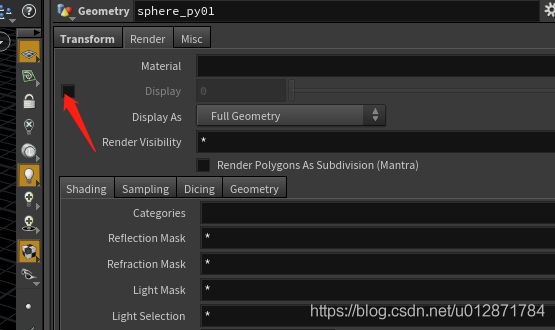Houdini With Python学习记(CHAO)录(XI)02
1.获取节点某帧的参数值
n = hou.node('/obj/sphere_py01/sphere1')
nTy = n.parm('ty')
nTy.evalAtFrame(4)测试:似乎得不到由表达式产生的值。
nTy.tuple()得到的是tx,ty,tz的元组
2.删除某个参数的关键帧
nRy = hou.parmTuple('/obj/sphere_py01/r')[1]
nRy.deleteAllKeyframes()
# nRy.deleteKeyframeAtFrame(3)3.设置某个参数的值
nRy = hou.parmTuple('/obj/sphere_py01/r')[1]
nRy.set(34)
nRy.setExpression("2*frame()")
#获得表达式字符串
nRy.expression()
#获得所有的关键帧
nRy.keyframes()
4.设置与获得DisplayFlag
n = hou.node('/obj/sphere_py01/sphere1')
n.setDisplayFlag(False)
n.isDisplayFlagSet()n.isObjectDisplayed()
5.设置节点是否可以选择
n.setSelectableInViewport(False)
# 获得状态
n.isSelectableInViewport()6.设置Xray
n.useXray(True)
n.isUsingXray()7.Transform
_parent = n.parentAndSubnetTransform()
_pre = n.preTransform()
_parm = n.parmTransform()
_world = n.worldTransform()
_product = _parent * _pre * _parm
print (_product == _world) # True
8.获得节点当前阶段的几何信息
_geo = hou.node('/obj/sphere1/AddPointNormals').geometry()
# 获得所有点
_points = _geo.points()
#打印每一个顶点的ID和POS
for p in _points:
_pos = p.position()
print "(%d) -> x=%f, y=%f, z=%f" % (p.number(), _pos[0], _pos[1], _pos[2])
#获得序号30-39(不包括39),每隔一个的点的集合
_glob = _geo.globPoints('30-39:2')
for p in _glob:
_pos = p.position()
print "(%d) -> x=%f, y=%f, z=%f" % (p.number(), _pos[0], _pos[1], _pos[2])
# 获得每一个prim的顶点集合
_prims = _geo.prims()
for p in _prims:
_verts = p.vertices()
buff = '('
for i in range(p.numVertices()):
buff += str(_verts[i].point().number()) + ' '
buff += ')'
print "%d) -> %s" % (p.number(), buff)
#将几何信息存成文件
_geo.saveToFile('C:/Temp/_geo.beo')
#获得点的属性
for attr in _geo.pointAttribs():
print attr9.关键帧
n = hou.node('/obj/ball')
nRz = n.parm('rz')
_keys = nRz.keyframes()
_key4 = _keys[3]
_key4.frame()
_key4.time()
_key4.expressionLanguage()
_key4.value()
_key4.slope()
_key4.accel()
#设置关键帧
_key4.setExpression('spline()')
_key4.setValue(45)
nRz.setKeyframe(_key4) #一定要执行这里,否则不会出现结果
10.hou.session
打开Python Source Editor写入
from hou import *
def popString(inputString = 'FUBAR'):
ui.displayMessage(inputString)打开Python Shell
hou.session.popString()
hou.session.popString("The life of a DA is always intense")
这样就会执行在sourceEditor里写入的popString的方法
获得sourceEditor里的内容
hou.sessionModuleSource()
想sourceEditor里追加代码
buff = '\ndef prod(a,b):\n return a*b'
hou.appendSessionModuleSource(buff)
执行之后,如果你打开着SourceEditor,那么并不好立即看到结果,需要点击SourceEditor的Reload,在弹出的对话框里选中OK
如果要覆盖整个SourceEditor的内容
hou.setSessionModuleSource(buff)
不要忘了reload一下
